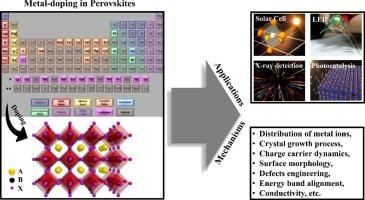Metal-doping for perovskite optoelectronic applications
IF 22
1区 材料科学
Q1 MATERIALS SCIENCE, MULTIDISCIPLINARY
引用次数: 0
Abstract
The last decade has witnessed a surge of research interests in metal halide perovskites, driven by their captivating optoelectronic characteristics. Introducing exotic metal ions for A- or B-site doping has been acknowledged as a viable strategy to enhance the quality of perovskite films and modify their intrinsic properties for different optoelectronic applications. Despite the great success of metal-doping strategy for perovskites, a systematic overview regarding their doping mechanisms and the precise roles of metal dopants is lacking. In this review, we first present an introduction regarding the fundamental understanding of metal-doping behavior, followed by a systematic analysis on the recent advances of metals ions (alkali metals, post-transition metals, alkaline-earth metals, transition metals and lanthanide rare-earth metals)-doping in perovskites for photovoltaic applications and beyond. An in-depth understanding of metal-doping mechanisms in perovskites was concluded, covering the dopant distributions and their impacts on tuning the crystal structure as well as optoelectronic properties of perovskite films. Finally, the insightful perspectives of metal-doping strategy in perovskite are provided to illuminate the future advancements in metal-doped perovskite optoelectronics.

钙钛矿光电应用中的金属掺杂
在过去的十年中,由于其迷人的光电特性,对金属卤化物钙钛矿的研究兴趣激增。引入外来金属离子用于A位或b位掺杂已被认为是提高钙钛矿薄膜质量和改变其内在性质的可行策略,可用于不同的光电应用。尽管钙钛矿的金属掺杂策略取得了巨大的成功,但对其掺杂机制和金属掺杂剂的确切作用缺乏系统的概述。在这篇综述中,我们首先介绍了金属掺杂行为的基本认识,然后系统分析了金属离子(碱金属、后过渡金属、碱土金属、过渡金属和镧系稀土金属)在钙钛矿中掺杂的最新进展,用于光伏及其他应用。深入了解了钙钛矿中的金属掺杂机制,包括掺杂物的分布及其对钙钛矿薄膜晶体结构和光电性能的影响。最后,对钙钛矿中金属掺杂策略的发展前景进行了展望,展望了金属掺杂钙钛矿光电子学的未来发展方向。
本文章由计算机程序翻译,如有差异,请以英文原文为准。
求助全文
约1分钟内获得全文
求助全文
来源期刊

Materials Today
工程技术-材料科学:综合
CiteScore
36.30
自引率
1.20%
发文量
237
审稿时长
23 days
期刊介绍:
Materials Today is the leading journal in the Materials Today family, focusing on the latest and most impactful work in the materials science community. With a reputation for excellence in news and reviews, the journal has now expanded its coverage to include original research and aims to be at the forefront of the field.
We welcome comprehensive articles, short communications, and review articles from established leaders in the rapidly evolving fields of materials science and related disciplines. We strive to provide authors with rigorous peer review, fast publication, and maximum exposure for their work. While we only accept the most significant manuscripts, our speedy evaluation process ensures that there are no unnecessary publication delays.
 求助内容:
求助内容: 应助结果提醒方式:
应助结果提醒方式:


